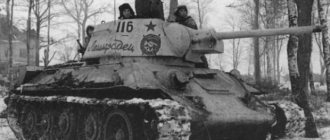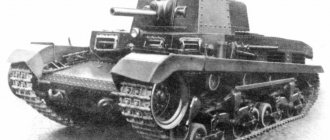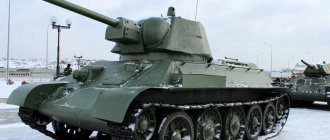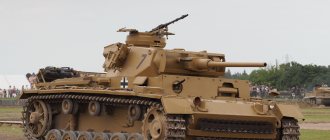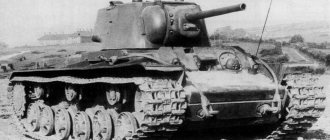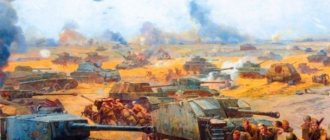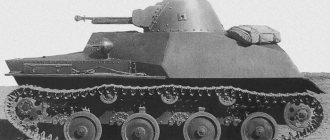Preparations for the “big war” in the Soviet Union gave world science and military science several very interesting examples of weapons and equipment. Some of them were unfairly slandered and trampled into the mud, such as, for example, self-loading rifles. Some were completely forgotten, lost among the many designs developed during the war years. Only interested people and specialists know about their existence. If they appear in photographs from the war, they cause sincere surprise and suspicion of photomontage.
Among the undeservedly forgotten and undervalued equipment, a special place is occupied by the KV-2 tank, which did not fall into any classification niche at the time of its creation. He inspired terror on the battlefield, but was powerless against the onslaught of the first year of the war. He took his first steps but was forgotten.
History of the KV-2
The interwar period is known in tank building as a time of miracles and the embodiment of the most interesting ideas of designers. The Soviet Union is the undisputed leader here. In addition to vehicles with several turrets, armed with guns and machine guns, which inspired awe and were terrible in standby readiness, but in reality, in battle, were not worth much.
However, truly iconic tanks were also created. Before the Soviet-Finnish war, it became clear that tank projects with several towers were a dead end.
Specialists from Leningrad are developing a heavy tank that was unique at that time, called the KV (“Kliment Voroshilov”). Contrary to popular belief, this tank was not created in a few months while Soviet troops tried in vain to break through the Mannerheim Line. Work on its design began back in 1938, when the smell of war was in full swing in Europe.
Tests in battles with the Finns showed excellent combat characteristics of the new vehicle.
Powerful armor made the tank almost invulnerable to Finnish artillery. Its small (compared to the T-35 and others) dimensions made it indispensable when storming enemy bunkers.
There were also disadvantages, the main one of which the military called the low-power 76-mm cannon for fighting fortifications. This is where the story happened, the will of the people turned to a fairly well-known HF.
Almost the entire plant worked in emergency mode for several weeks in order to fulfill the army order. The journey from the order to the finished prototype took a record 2 weeks.
The birth and baptism of fire of the tank
At the Kirov plant they decided not to waste time on trifles and install a 152 mm gun instead of the 76 mm cannon. Since there was no time, they decided to install it in a rather unsightly metal box with a wall thickness of about 70 mm.
The main problem that concerned everyone was the danger of capsizing when fired.
In order to immediately place all the points, the car was turned sideways at the training ground. The shot not only did not overturn the hull, but also did not affect the power plant, as the engineers feared. After testing the gun, the car started up as if nothing had happened.
Having tested several more units installed specifically for this modification, it was sent to the active army on the Karelian Isthmus. By the time they arrived, the main line of defense had been breached and the war was coming to an end. Despite this, there were still a large number of firing points, which the prototype was sent to storm.
In battle, he showed himself at his best. Anti-tank artillery was unable to hit a single vehicle. On one of the KVs “with a big turret,” as the tank was then called, they scored 48 hits without penetrating the armor. It goes without saying that such a miracle with a large turret was immediately put into service, despite numerous technical shortcomings.
Tank design
The description of the lower chassis is identical to the KV-1 tank. The body is of welded type, made of rolled armor. The KV-2 tank was one of the first to receive the same armor on the hull, that is, all the vertical plates of the forehead, stern, sides, and turret were 75 mm thick. Horizontal slabs had a thickness of 55, 40 and 20 mm.
The turret, which stands out for its height, had a rough shape on the first models, and the haste in creating the tank was visible.
Later cars are distinguished by greater elegance and ergonomics in the turret. To reduce the silhouette and reduce weight, the subsequent release received a “low tower”. An armored door was made on the back of the turret for unloading and loading ammunition, as well as making it easier for the crew to board. The new gun required more tankers. The KV-2 gun mantlet, which was redesigned several times, provided balance and protection for the gun's mechanisms.
The power plant of the vehicle includes a V-2K diesel unit. The engine had 12 cylinders arranged in a V-shape, rated power 500 hp.
Later it was modernized due to the large mass of the tank, increasing the power to 600 hp. Mechanical transmission with multi-disc main clutch. During operation, it was the one that had the most questions. The unreliability of this particular unit will subsequently play a tragic role in the fate of many vehicle crews. The suspension is torsion bar type, with 6 road wheels and 3 support rollers. The caterpillar consisted of 86-90 tracks with a width of 700 mm.
The electrical wiring was of a single-wire type, instead of a second type, and the tank hull was working at a disadvantage. Only the emergency lighting had two wires. Energy was provided by a generator connected to 4 batteries. There were quite a lot of energy consumers in the car:
- car lighting outside and inside;
- illumination of instruments and sights;
- electric drive for turning the tower;
- sound signal;
- intercom and communication equipment;
- starter and engine relay.
The crew of the KV-2 heavy tank consisted of 6 people. The driver and radio operator were in the hull, the rest of the crew were in the turret near the gun. For viewing, viewing devices with triplexes and shutters were installed, in which there were viewing slots. The gun was fired using optical and periscopic sights. KV-2 machine guns could be equipped with their own sights, borrowed from Mosin sniper rifles.
The main weapon of the KV-2 tank was the 152mm M-10T howitzer.
It was fired mechanically, using a trigger lever. Each tank contained 36 separate rounds. The state's ammunition was of the same type, high-explosive fragmentation. However, during use, the tank crews loaded and fired the gun with almost all available 152mm howitzer rounds. This also includes shots for naval howitzers. The only limitation was in sorting and reducing the ammunition charge.
To combat infantry, 3 standard DT machine guns were installed. One was located in the ball of the gunner-radio operator, the second stood next to the gun, the third protected the rear and was located in the rear of the turret. Some versions of the KV-2 with a large turret were equipped with an anti-aircraft machine gun on the turret. In the event of damage to the vehicle and the evacuation of the KV-2 crew, all diesel fuel could be removed and used separately. It’s a pity that the weapon could not be pulled out.
The high height of the tank, due to the design of the gun, is noteworthy. But the dimensions were compensated by the thickness of the armor and the effectiveness of the projectiles. For example, the weight of the charge in a high-explosive fragmentation grenade was 5.5-6.86 kg. Here are the main characteristics of the tank in comparison with the most famous ones from the Second World War.
| KV-2 | KV-1 | T-34 | Tiger | Panther | |
| Weight, kg | 52000 | 43000 | 30000 | 57000 | 44800 |
| Length, mm | 6950 | 6675 | 5920 | 6316 | 6870 |
| Width, mm | 3320 | 3320 | 3000 | 3705 | 3270 |
| Height, mm | 3250 | 2710 | 2405 | 2930 | 2995 |
| Cruising range, km | 150-250 | 200 | 380 | 195 | 250 |
| Travel speed, km/h | 16-34 | 34 | 36-40 | 20-25 | 25-30 |
The significant weight of the vehicle made it somewhat difficult to move over bridges and soft ground. But this problem equally affected the KV-1.
Late modification
Since 1942, the Red Army has systematized the experience of using HF. The conclusion was seemingly logical - there are problems due to the fact that the tank is too heavy. Moreover, for most conditions the reservation turned out to be excessive. The optimal solution is to lighten the vehicle, increasing the reliability and maneuverability of the HF.
The lightweight modification was called KV-1S - “high-speed”. The weight decreased from 47 to 42 tons, the speed increased by tens of kilometers per hour. The reliability of the units has also increased due to the fact that the load on them has been noticeably reduced.
KV-1S tanks (waralbum.ru)
KV-1S tanks (waralbum.ru)
Combat service in the Great Patriotic War
The first documented meeting of the Germans with the Soviet KV-2 tank during the Great Patriotic War occurred on June 23, 1941. To say that the Germans were unpleasantly surprised is to say nothing. The steel monster with a huge turret, thick armor and a 152mm gun didn’t leave a single chance. When meeting him, any German tanks at the beginning of the war became tankettes.
According to numerous testimonies, 37mm shells simply bounced off the KV-2’s armor. The 152mm gun turned German vehicles into a pile of rubble. The machine guns were reliably protected from the infantry, so theoretically there should have been no problems in battle.
The system, which had no analogues at that time, became a headache for the Germans throughout 1941.
To effectively combat the KV-2, several tactics were invented. The surest way was to destroy the gun with a sniper shot. Having lost its cannon, the vehicle became practically toothless; with three machine guns you couldn’t fight much. Another weak point of the KV-2 was the chassis. Having broken the tracks or disrupted the rollers, the artillerymen passed the baton to the infantry and sappers. The latter threw grenades at the immobilized car or blew it up with explosive charges.
They also practiced shooting KVs with heavy artillery. The Wehrmacht's lifesaver, the Flak 18/36/37 anti-aircraft gun, an 88-mm gun, also saved our lives.
But the main enemy of the KV-2 with a large turret was not German armored vehicles. The confusion of the first months of the war, the destroyed rear, problems with the supply of ammunition and fuels and lubricants did much more to destroy the formidable tanks than the German units opposing them directly in battle. Thus, out of 33 KV-2 units in the 41st Tank Division, only 5 were lost in battle, the remaining two-thirds were abandoned during the retreat due to difficulties with fuel and repairs.
The specifics of the KV-2 implied a breakthrough through the enemy’s defensive lines, and not in a maneuverable war, often surrounded or separated from the rear. In the summer of 1941, the Red Army did not have to break through the defenses, and the armored giants had to be exchanged for small change, using them for non-core tasks.
In September 1941, Leningrad was surrounded, and the Kirov plant was forced to sharply reduce the production of combat vehicles. The KV-2 with a heavy 152 mm gun and a large turret turned out to be unnecessary; all possible potential manufacturers switched to producing a simpler version of the KV-1 with a small turret and gun.
The formidable vehicle was reborn already in the middle of the war, when the self-propelled gun ISU-152, armed with a 152-mm gun, began to enter service.
Of course, one cannot say that these were relatives, but many moments in “St. John’s Wort” were reminiscent of the KV-2, which had been forgotten by that time. The Germans were as afraid of the car as they were of the KV-2.
Today there are only a couple of original cars left in the world. One of them is located in Moscow, on display at the Central Museum of the Armed Forces. The second tank, in the most complete state of preservation, is located in the Sverdlovsk region, in the UMMC Museum of Military Equipment. The third model, created for the filming of the feature film “Klim Voroshilov-2”, is located in the Murmansk region.
Since the basis of the model was the IS-2M, the model can hardly be called similar to the original KV-2, except for the turret there is nothing similar there. Interestingly, vehicles with large turrets like the KV-2 are often found in early war vehicles. The conversions of the Finnish army from Soviet trophies and the English-made Bishop self-propelled gun are prime examples of this.
In general, the movie is not too fond of this tank model.
In games, the KV-2 is much more common. For the sake of playability, the KV with a 152 mm gun from the games differs from the vehicle in reality, but in battle it is still considered one of the strongest vehicles. The most epic appearance in world culture occurred in the Japanese franchise "Girlsund Panzer", which tells the story of Japanese schoolgirls racing various tanks from around the world.
Great War
This KV-1 will take part in the Battle of Moscow. December 1941 (waralbum.ru)
This KV-1 will take part in the Battle of Moscow. December 1941 (waralbum.ru)
The KV could deliver effective strikes even in the chaos of the summer of 1941. So, for example, near Raseiniai, on the second day of the war, 20 KV tanks collided with a hundred German tanks. The lion's share of the latter were Czech "Pragues". The result was the defeat of enemy tanks, and a battery of 150-mm howitzers was also crushed.
The anti-tank defense could not cope with the KV tank either. In some cases, our vehicles simply rolled along it, crushing materiel and shooting enemy soldiers.
True, one should not think that the KV was invulnerable - enemy tanks could use difficult-to-manufacture and expensive sub-caliber shells and, bypassing a heavy tank from behind, thoroughly “ruin its skin.” The Germans could also use 88-mm anti-aircraft guns - in the future this weapon will be installed on the Tiger - and shoot the KV even from long distances. Well, or call in Stuka dive bombers - the accuracy of their bombing made it possible to effectively fight tanks. Therefore, a battle with such a dangerous enemy as parts of the Wehrmacht required a fair amount of courage and skill from the KV crew.


